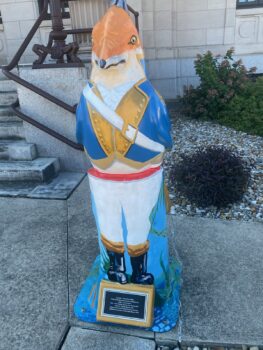Marion’s founders had one hero in mind when naming the city: Revolutionary War General Francis Marion, nicknamed the “Swamp Fox.”

“He is mentioned in a few of the early Marion County History books. The reason we are named Marion is a tribute to this extraordinary general,” said Brandi Wilson, executive director of the Marion County Historical Society.
While the only memorial to the Swamp Fox is the cardinal outside Heritage Hall, there were other tributes to this legend.
“My grandparents used to belong to a camping club formed here in 1965 called the Marion Swamp Fox Camping Club,” Wilson said.
In addition to patches and photos, an article in The Marion Star on May 23, 1966, documents their adventures. Wilson’s great aunt and great uncle, Edna and Harry Lones, were among local Swamp Fox Club members who attended a national camping convention. They heard Gov. James Rhodes address 3,500 campers. According to the article, the Ohio governor “commended the parents for providing a family participation program, therefore lowering juvenile delinquency and divorce rates.”
Who was the Swamp Fox?

“Marion is an interesting figure, and one who has been popularized and mythologized a bit, even becoming the basis of Mel Gibson’s The Patriot. His guerilla tactics made him a hero during and after the Revolutionary War, especially since American victories were hard to come by — and even fewer when not achieved by George Washington,” said Dr. Jason Tingler, a history professor at Marion Technical College. “Early American patriots did their part to celebrate these successes, which is why he became so popular in the first decades of independence.”
Marion was born on a plantation in South Carolina in 1732. He fought in the French and Indian War, which honed the tactics he used to battle the British in the Revolutionary War.
The National Park Service states that Marion fought in the Battle of Sullivan’s Island when 400 South Carolinians successfully defended Charleston Harbor from the British Royal Navy.
Marion was forced to sit on the sidelines and avoided the disastrous siege of Savannah in 1779. The National Parks Service says Marion was injured after he jumped out of a second-story window to escape drunken revelers at a party.
After he recovered, Marion targeted British communications and supply lines in the South Carolina low country. The National Park Service says British Lieutenant Colonel Banastre Tarleton tried and failed to stop Marion, saying, “as for this old Fox, the Devil himself could not catch him!”
After the war ended, Marion returned to farming and served in the South Carolina State Senate. He died in 1795.
“Today, we can see a more complex history beyond the military successes. Marion’s grandfather had fled religious persecution in 17th century France and was granted lands in the Carolina colony by some English lords,” Dr. Tingler said. “Marion would be born there, on a Southern plantation with slaves, and several slaves were even assigned to his care at birth. He owned slaves all his life, but did emancipate a few upon his death, although not all.”
Marion’s battles against the Cherokees during the French and Indian War were brutal.

“Marion’s successes in the Revolutionary War and his ambush tactics were also shaped by his earlier experiences during the Cherokee War, where he saw the effectiveness of mobility and quick strikes. During this campaign, Marion’s unit participated in the purposeful destruction of Cherokee homes, crops, and land,” Dr. Tingler said. “These wanton actions were based upon a superior’s order, and Marion expressed some sorrow about them, but he also noted how many of his men enjoyed such actions.”
Historians look at Marion’s full legacy.
“Marion is an important military hero, who achieved important victories against the British military during the revolution, but he also reflected some of the early tragedies in our nation’s history. In this regard, and as so often said, he was a man of his times,” said Dr. Tingler.


















